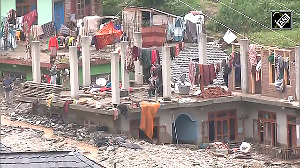'I kept begging the doctors to put my three year old on the ventilator. But the doctors and nurses kept saying no ventilator was available. When the breathing apparatus ultimately became available, it was too late.'
Indrani Roy/Rediff.com travelled to Cuttack to find out why 65 children died at the city's Sishu Bhawan last month.

Photograph: ANI
"Don't take my photograph, please. I lost my youngest child and if my photo appears in the newspapers, it will be difficult for me to get treatment for my other children at Sishu Bhawan," a woman in her mid-thirties, in heavily accented Odia, tells me on a sunny morning last week.
As an Odisha associate of mine translates what she meant in Hindi, the woman adds, "My nine-month-old daughter was diagnosed with broncho-pneumonia in the last week of August."
As the primary healthcare centre in her village could not treat the infant, the child was rushed to Sishu Bhawan.
"She needed to be taken to the ICU (intensive care unit). But no bed was available in the ICU when we reached. My child was given an ordinary bed. I sat beside her and kept waiting," the mother recalls her nightmare.
"After almost an hour, she stopped moving. I took her in my arms. She was not breathing," the woman says, tears rolling down her cheeks.
65 deaths in 20 days
Cuttack's Sardar Vallabhbhai Patel Post Graduate Institute of Paediatrics -- Sishu Bhawan -- recently grabbed the headlines for the wrong reasons when 65 children died at the hospital in a span of 15 to 20 days.
When it comes to the infant mortality rate, Odisha stands above the national average at 51 per 1,000 child births (the third highest in the country) against the national average of 40.
Hospital records are alarming
Records available with Sishu Bhawan staff, and with the Odisha state health department, reveal an alarming rise in the number of infant deaths in recent years.
- In 2015, according to information available, the hospital admitted 11,250 children till the end of August; of these, 965 did not survive.
- In 2014, the hospital admitted 18,271 children; 1,522 of them did not survive.
- In 2013, of the 12,683 children admitted, 1,033 did not survive.
According to the Odisha health department, the cause of death in most cases was either septicaemia or pneumonia.
Most of the infants who died were born prematurely and had low birth weight.
Many of the families who lost a child blame the deaths on the hospital's poor infrastructure and lack of competent staff.
"I lost my son because of the doctors and nurses at Sishu Bhawan," says a middle-aged man hailing from Keonjhar, northern Odisha.
In Cuttack to perform his son's sraddh (a ceremony performed a few days after the demise of a person), the man sobs uncontrollably. "I kept begging the doctors to put my three year old on the ventilator. But the doctors and nurses kept saying no ventilator was available. When the breathing apparatus ultimately became available, it was too late."

Photograph: ANI
Does Sishu Bhawan lack infrastructure?
One of the biggest paediatric hospitals in eastern India, Sishu Bhawan attends to around 450 patients each day.
The number increased after its merger with the paediatrics unit of Cuttack's SCB Medical College and Hospital.
According to insiders, the merger aggravated matters as it increased the number of patients.
"There was no increase in the number of staff after the merger as a result of which it has become more difficult to attend to emergencies," a member of the hospital staff told Rediff.com, speaking on condition of anonymity.
Though the number of patients continues to rise, the 416-bed hospital has only 89 doctors and 173 nursing professionals, the source adds. It has eight ventilators and 21 critical care beds in the neo-natal intensive care unit and paediatric intensive care unit.
"These are too meagre to cope with the huge rush of patients," says a state health ministry official, who does not want to be named for this report.
"We should not forget that a great number of infants are referred here from district hospitals and rural health centres," the health ministry official adds. "Most of these infants come in critical condition. Unless Sishu Bhawan scales up its facilities, deaths can't be prevented."
'Critical care facilities need improvement'
"While there is a hue and cry over the death of infants at Sishu Bhawan, let us not forget that this is essentially a referral hospital," Dr Arabinda Mohanty, president, Indian Academy of Pediatrics (East Zone), tells Rediff.com
"Many deaths can be prevented if healthcare facilities are improved at the district and village level," Dr Mohanty adds.
"Often, infants in very critical condition are brought from faraway places and crucial time is wasted in commuting," he says. "Since one can get a free ambulance service in Odisha by just dialing 108, health centres in districts and villages blindly refer patients to Sishu Bhawan."
"Sishu Bhawan is well equipped and smartly planned," Dr Mohanty points out, "but all these features are of no use if it does not have adequate staff."
"A preliminary inquiry report by the Cuttack district administration found that the infants who died were born prematurely and had low birth weight," he says. "Most of the infants died because of delayed intervention, septicemia and hypoglycemia."
"Moreover," Dr Mohanty says, "the parents did not know how to maintain proper hygiene. They often carried ailing babies wrapped in dirty clothes. Moreover, there would be five to six people per patient and some of them could be seen sitting on the babies' hospital beds."

When I visit Sishu Bhawan last week, I find the wards full, each ailing child with at least five to six people in attendance.
Some of those in attendance reveal they have been staying on the hospital premises for days.
Some of them are seen washing clothes and hanging them to dry within the Sishu Bhawan compound (see image left. Photograph: Indrani Roy).
'Lack of staff at Sishu Bhawan is a major concern'
According to Saila Behera, general secretary of the non-government organisation Basundhara in Cuttack, the state government needs to immediately appoint more doctors, nurses and paramedics.
"I have worked closely with Sishu Bhawan and I have noticed how the doctors and nurses there struggle to meet emergencies, especially at night," Behera tells Rediff.com
Moreover, she adds, health care centres in the districts and villages need to be pulled up for referring virtually every case to Sishu Bhawan.
"The government should pass a law that would compel the health centres to treat an ailing child first," Behera says.
Behera, like Dr Mohanty, believes since parents can avail of the Odisha's free ambulance service, they arrive at Sishu Bhawan with critically ill infants. Since a considerable amount of time is lost in transit, deaths cannot be avoided.
"Doctors at Sishu Bhawan were not negligent," says Behera. "I know them personally. They are competent and energetic, but need more support from the government."
"It is time the government realises it is impossible to take care of so many people with such a thin staff," adds Behera.
'Infants arrive in very critical condition'
"Most of the children who died at Sishu Bhawan came in a very critical condition," says Rajlakshmi Das, acting chairperson, Odisha State Commission for Protection of Child Rights.
"Sishu Bhawan faces a tremendous rush of patients from June to September as babies are prone to diseases during the monsoon," Das tells Rediff.com
"This year, following the rains, there was an outbreak of pneumonia among infants. Patients from places as far off as Jharkhand and the Bengal-Odisha border towns were brought to Sishu Bhawan," she adds.
"Most of the children were in a critical or very critical condition. Sishu Bhawan doctors couldn't save them as crucial time had been lost in the commute."
"I am quite sure there wasn't any medical negligence behind the deaths," emphasies Das.
What the government has done
Following the deaths at Sishu Bhawan, the Odisha government set up a technical committee headed by the director of medical education and training.
In the second week of September, Odisha Health Secretary Arati Ahuja told the media that the report had indicated 'administrative and management slackness,' but 'no clinical negligence.'
Soon after receiving the report, the Odisha government transferred Sishu Bhawan superintendent Dr Niranjan Mohanty to the Berhampur MKCG Medical College and Hospital. He has been replaced by Dr Saroj Sathpathy.
The Odisha government has also decided to increase the number of beds in the sick newborn care unit and the newborn intensive care unit on a priority basis.
State Health Minister Atanu Sabyasachi Nayak announced that Rs 20 crore (Rs 200 million) will be sanctioned to the hospital for the expansion of wards.
The hospital will also be granted Rs 100 crore (Rs 1 billion) for a new building.
On September 2, the Odisha government suspended six Sishu Bhawan staff members. The suspended staff included two staff nurses, three medical attendants and a sweeper. Two more nurses were transferred on administrative grounds.
Union Health Minister J P Nadda sent a four-member team of experts to Sishu Bhawan. The team discovered there was a shortage of doctors and paramedics and inadequate infrastructure. It suggested strict monitoring of sick children, round-the-clock facilities for clinical investigations inside Sishu Bhawan and a regular infection surveillance system.

Photograph: PTI
India unlikely to meet infant mortality rate target for 2015
The infant deaths at Sishu Bhawan have dealt a blow to India's infant mortality rates.
A United Nations Children's Fund report states that India is unlikely to achieve its target of reducing the infant mortality rate to less than 39 per 1,000 lives.
India accounts for the highest number of under-five deaths in the world, though there has been a faster decline in its reduction as compared to the global fall, the UNICEF report says.
Assam, with 75 deaths per 1,000 live births, tops the chart among Indian states having an under-five mortality. Assam is followed by Madhya Pradesh (73), Odisha and Uttar Pradesh (68), Rajasthan (59), Bihar (57) and Chhattisgarh (55). The national average is 52 deaths per 1,000 live births.
'The infant mortality rate of India is 40 per 1,000 live births while the under-five mortality rate is 52 per 1,000 live births,' Gagan Gupta, UNICEF's health specialist in India, told Press Trust of India.
According to him, 1.34 million children die before completing five years every year in India, of which 748,000 die within the first month of their life.
'This means more than 2,000 newborns die each day in India,' he said.
If the authorities at Sishu Bhawan don't take drastic steps to prevent more deaths in the future, this number is sure to go up.











